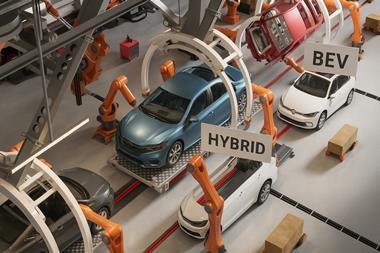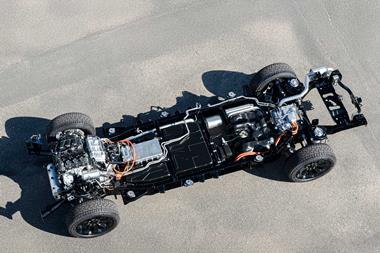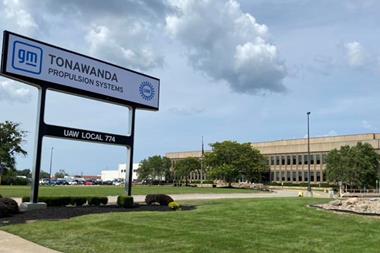Jaguar’s Castle Bromwich factory near Birmingham, UK, currently spearheads production of its latest models. AMS reports on operations at the site
Home of the iconic brand ’s production, JLR’s Castle Bromwich plant covers 110 acres, employs around 3,200 people and is currently the sole Jaguar plant, a position which will change when Jaguars are added to the Solihull line-up in 2015. The current production line-up consists of the XF, XJ, XK and the new F-Type cabriole and coupe, production of the coupe having started at the end of 2013.
’s production, JLR’s Castle Bromwich plant covers 110 acres, employs around 3,200 people and is currently the sole Jaguar plant, a position which will change when Jaguars are added to the Solihull line-up in 2015. The current production line-up consists of the XF, XJ, XK and the new F-Type cabriole and coupe, production of the coupe having started at the end of 2013.
The XF and XJ have body-in-white (BIW) and final trim and assembly lines of their own, while the XK and F-Type share an assembly line. In addition, the plant also has three Muller-Weingarten hydraulic press lines, with a maximum of 2,000 tonnes force on the lead press. One line has six stations, one has four and the third has just three presses, with a fourth due to come on stream within the next two years. The lines produce a mix of aluminium and steel panels for the Jaguar models made at Castle Bromwich and a number of parts for Land Rover at Solihull. This arrangement will continue once the new line arrives and the new C-X17 models go into production at Solihull. The steel parts are used on the XF, which is the only steel-body vehicle in the Jaguar line-up.
XJ body shop
The XJ body shop uses around 90 Kawasaki and 20 ABB robots, assembling 290 body parts for the XJ. There are around 260 parts on the XF, which is welded because it is made of steel. The XJ, which is more than 90% aluminium, is mostly joined with rivets supplied by Henrob. The system uses reels of rivets which need to be replaced by an operator when they run out; by contrast, the riveting system used at Solihull involves a continuous supply of rivets from hoppers. The XJ uses nearly 3,200 self-piercing rivets and more than 150 metres of adhesive which is heated to 170°C for 15 minutes to set.
Just before the end of the XJ body line, the panels are checked for dimensional and fitting accuracy using handheld gauges. This stage also involves checking the height of the rivets to ensure they have been fitted correctly.
100% build-to-order
All Jaguars are built to order, with no stock units currently built. The XJ takes just 48 hours from the first pressing being made to a finished vehicle coming off the end of the line, although because the XJ line is currently only running on a one-shift basis, in practice it takes more than a week to appear once the first pressing is made. By comparison, the XF requires 38 hours of processing time and the F-Type around 42 hours.
The assembly lines operate on an electronic kanban system, where the operator at each station orders fresh component or material supplies when stock at his station has reached a pre-set level. Parts are delivered to the stations by DHL, which runs the internal logistics for all JLR plants.
Internal logistics
In terms of logistics, suppliers sequence seats, door casings, headliners, bumpers, wheel-tyre assemblies and wiring harnesses in their own plants. The trucks delivering these parts reverse up to the building, and with automatic unloading the parts are not actually touched by hand from the moment they are loaded at the supplier until they are needed on the line. Inside the plant, a number of other parts are sequenced by DHL. One example of the sequencing comes in the area of rear suspension parts; the XF estate (Sportbrake) has an air suspension system at the rear, but on the standard XF there is a spring suspension set-up on both the front and rear of the car.
XF assembly line
The XF final trim and assembly line has five distinct elements, or sub-lines, as the car proceeds back and forth within the factory. Parts one and two are linked and form a continuous line. Here the bodies move on skillets, with space for the assembly line workers to stand on; the worker is stationary as the body moves along the assembly line. Parts three and four involve the body being lifted above the workers, so they can carry out the necessary work on the underbody. At the end of part four, the XF is lifted up out of the final trim shop and carried by an over-road conveyor into a neighbouring building where the engine and transmission are fitted to the body.

The engines come almost ready to fit from the Ford plant in Bridgend. The only additional stages carried out at Castle Bromwich are the addition of the air conditioning and cooling hoses and the fitting of the engine wiring harness. It is worth noting that the final trim hall for the XF and XJ lines involve almost entirely manual work, with only two robotic stations, for the rear and front windscreens.
The end of the line
Once the powertrain has been fitted to the body, the nearly completed car is then moved back through a second over-road conveyor in to the final trim shop. Here, final trim parts and seats are fitted, engine ECU and other software are programmed in and lubricants and other liquids are filled. This is followed by a water spray/leak test. The full electrical testing at the end of the line takes around 20 minutes, while the water test involves 6,000 litres of water (which comes from the factory’s own bore hole supply) being sprayed over the vehicles for four minutes. An XF comes off the end of the assembly line every two-and-a half minutes, while in a neighbouring hall an XJ comes off the line every four minutes. On the XK/F-Type line, a completed vehicle comes off the line every six minutes.
JLR’s story of success
Jaguar Land Rover is one of the great current success stories of UK business, not just the automotive sector. Its Halewood plant cannot produce enough Range Rover Evoques to meet demand, especially from China, while the Solihull plant will soon add a new range of all-aluminium Jaguars and Land Rovers to its production lines; the initial C-X17 concept for these models was shown at the Frankfurt motor show in September 2013.
Meanwhile, the company is expanding internationally. A joint venture (JV) with Chery in China will see its own vehicles and a new JV brand’s models appear within the next few years. CKD assembly is under way in India and a letter of intent has been signed with the Saudi Arabian government to establish some form of manufacturing facility in the country – although whether this will end up producing aluminium components or complete vehicles remains to be seen. In early December 2013, JLR confirmed it would build an all-new factory in Brazil, its first on the American continent, with the first vehicles coming off the new line in 2016. An investment of £240m ($393m) will result in an initial annual capacity of 24,000 vehicles.
Back in the UK, the company’s first engine plant is under construction at Wolverhampton, involving a total investment of more than £1.1 billion, creating at least 1,400 jobs in the factory and around a further 5,500 in the supply chain, mostly in the UK. The new factory will feature more than 90 state-of-the-art machining centres, producing a new series of four-cylinder diesel and petrol units, the first coming off the line in early 2015.
The company employs more than 25,000 people in the UK, supporting a further 80,000 in the supply chain; it claims to represent around three-quarters of all UK automotive investment and is also the largest investor in automotive R&D in the UK, with a combined R&D and capital investment in the UK in 2013/14 of around £2.75 billion. The company will spend around £6 billion with UK suppliers in 2013/14, a sum which represents over half of its total purchasing spend. UK spending is expecting to grow by around 50% through to 2017.
Having produced record results in the last financial year, the 2013/2014 fiscal year has seen a further impressive performance. JLR’s revenue in Q2 (to September 2013) rose 40% year-on-year to £4.6 billion; unit sales for the first half of the fiscal year were up 16% to just over 197,000 units worldwide, while half-year revenues were just over £8.7 billion, up 26% year-on-year. Profit before tax, at just over £1 billion, was up 42% year-on-year.






































